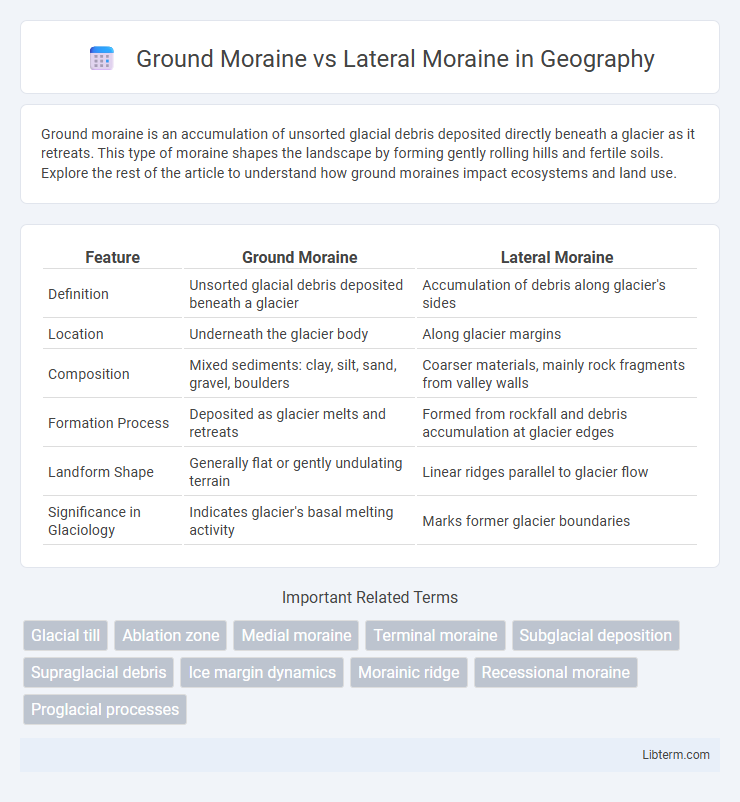Ground moraine is an accumulation of unsorted glacial debris deposited directly beneath a glacier as it retreats. This type of moraine shapes the landscape by forming gently rolling hills and fertile soils. Explore the rest of the article to understand how ground moraines impact ecosystems and land use.
Table of Comparison
| Feature | Ground Moraine | Lateral Moraine |
|---|---|---|
| Definition | Unsorted glacial debris deposited beneath a glacier | Accumulation of debris along glacier's sides |
| Location | Underneath the glacier body | Along glacier margins |
| Composition | Mixed sediments: clay, silt, sand, gravel, boulders | Coarser materials, mainly rock fragments from valley walls |
| Formation Process | Deposited as glacier melts and retreats | Formed from rockfall and debris accumulation at glacier edges |
| Landform Shape | Generally flat or gently undulating terrain | Linear ridges parallel to glacier flow |
| Significance in Glaciology | Indicates glacier's basal melting activity | Marks former glacier boundaries |
Introduction to Glacial Moraines
Ground moraines form as glaciers deposit unsorted sediment called till directly beneath the ice, creating a gently rolling landscape with a mix of clay, sand, gravel, and boulders. Lateral moraines develop along the sides of glaciers, consisting mainly of debris that has fallen from valley walls and accumulated parallel to the glacier's path. Both types of moraines are key indicators of past glacial movement and help reconstruct ancient ice flow patterns and climate conditions.
What Is a Ground Moraine?
A ground moraine is an extensive, gently undulating layer of till deposited beneath a glacier as it retreats, characterized by a mix of clay, sand, gravel, and boulders. Unlike lateral moraines that form along glacier edges, ground moraines blanket large areas of land, creating fertile soils and influencing post-glacial landscapes. Their distribution and sediment composition provide crucial information about past glacial movements and the dynamics of ice sheets.
Characteristics of Ground Moraines
Ground moraines are extensive, gently rolling deposits of till left behind by retreating glaciers, characterized by unsorted mixtures of clay, sand, gravel, and boulders. Unlike lateral moraines, which form as ridges along glacier sides, ground moraines cover broad areas beneath the glacier's path, creating relatively flat or gently undulating terrain. These formations provide valuable insights into glacial movement and sediment distribution, often supporting fertile soil development due to their varied particle sizes.
What Is a Lateral Moraine?
A lateral moraine is a ridge of debris deposited along the sides of a glacier, formed from material falling off valley walls and carried by the moving ice. Unlike a ground moraine, which consists of sediment spread evenly beneath a glacier, lateral moraines are linear accumulations marking the glacier's edges. These ridges provide key insights into past glacier extents and dynamics in glaciated landscapes.
Distinct Features of Lateral Moraines
Lateral moraines form distinct ridges of debris deposited along the sides of glaciers, highlighting the accumulation of sediments that were transported from valley walls. These moraines are typically elevated compared to ground moraines, which consist of unsorted till spread beneath the glacier. The prominent linear ridges of lateral moraines serve as clear markers of former glacier margins and are often composed of mixed rock sizes, from fine sediments to large boulders.
Formation Processes: Ground vs. Lateral Moraines
Ground moraines form from the accumulation of unsorted glacial debris deposited directly beneath a glacier as it advances and retreats, resulting in a blanket of till over the landscape. Lateral moraines develop along the sides of glaciers, created by material that falls from valley walls or is pushed aside by the flowing ice, forming ridges parallel to the glacier's edges. The distinction between ground and lateral moraines lies in their depositional environment, with ground moraines reflecting subglacial processes and lateral moraines representing supraglacial debris accumulation.
Differences in Appearance and Structure
Ground moraines consist of a widespread, undulating layer of till deposited beneath a glacier, characterized by a relatively smooth and flat surface with scattered ridges and hummocks. Lateral moraines form as distinct, linear ridges along the glacier's sides, composed of coarser debris accumulated from rockfall and erosion. The primary difference is that ground moraines create broad, low-relief terrain, while lateral moraines appear as prominent, elongated ridges marking the glacier's margins.
Ecological Impact of Both Moraine Types
Ground moraines, composed of unsorted glacial debris, create diverse microhabitats that support early successional plant species and enhance soil fertility, promoting ecological succession in glaciated landscapes. Lateral moraines, characterized by ridges of rock and sediment along glacier edges, influence local hydrology by redirecting meltwater streams, which can create unique aquatic habitats and affect nutrient distribution. Both moraine types contribute to landscape heterogeneity, fostering biodiversity by providing varied substrates and influencing vegetation patterns in their respective environments.
Ground Moraine and Lateral Moraine: Real-World Examples
Ground moraine forms extensive, gently undulating deposits of till left beneath glaciers, evidenced by the vast till plains of the Midwest United States, such as the Minnesota and Wisconsin areas. Lateral moraine consists of ridges composed of debris deposited along glacier edges, prominently seen in the Swiss Alps, particularly near the Rhone Glacier. Comparing these, ground moraines represent widespread basal debris accumulation, while lateral moraines mark glacier margins with more linear, elevated ridges.
Conclusion: Comparing Ground and Lateral Moraines
Ground moraines consist of unsorted glacial debris spread across the landscape as a glacier retreats, forming a gently rolling or flat terrain, whereas lateral moraines are ridges of debris deposited along the glacier's sides, creating prominent linear features. Ground moraines indicate widespread sediment deposition beneath the ice, reflecting glacier thickness and movement, while lateral moraines mark the glacier boundaries and provide insights into glacier margins and former ice extent. Comparing these moraines reveals contrasting depositional processes and landform characteristics crucial for reconstructing past glacial environments and understanding glacier dynamics.
Ground Moraine Infographic

 libterm.com
libterm.com